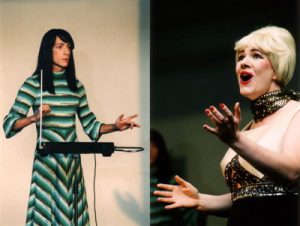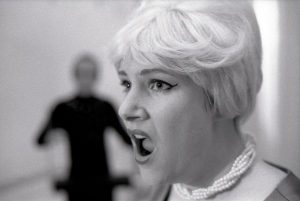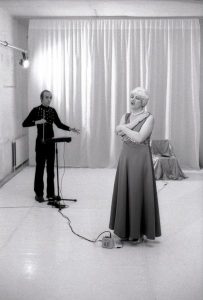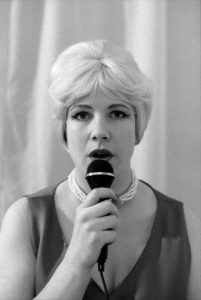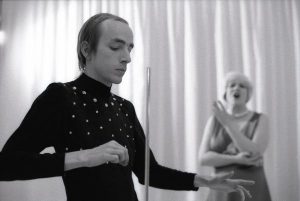WITHOUT YOU, I AM NOTHING
In Without you, I am Nothing, voice and speech, body and mind are uniquely tied together in the singing of the opera diva.
On the stage is a golden chair with a microphone on it, a small amplifier, a theremin, and black cables connecting all these things, creating a tight triangle. Antonia, the diva, enters in a lovely sparkly gown, sits down in the chair and delivers a hypnosis text based on a fantasy of being in love with and performing for a queen. She speaks a little sideways to an audience which will choose either to sink into her fantasies and suggestions or to detach themselves and listen, scrutenizing the text and the scenario. After she finishes her hypnosis, she lip-synchs to William playing Giuseppe Verdi’s “Tu che le vanità” on the theremin, making it sound like an operatic soprano voice. Seeing and hearing, disbelieve and wanting to believe are all combined. Musician/instrument, text/speech, audience/vision in general become blurred.
Logic dances in a field of flowers for a moment, and something like a trance is made possible.
Without You, I am Nothing
A performance by William Wheeler
With Antonia Baehr and William Wheeler
Production: Wheeler/Baehr and Podewil Berlin
Premiere: 2001
Duration: ca. 30min.
Without you, I am Nothing, William Wheeler
„In Without you, I am Nothing, voice and speech, body and mind are uniquely tied together in the singing of the opera diva.“
In Without you, I am Nothing, voice and speech, body and mind are uniquely tied together in the singing of the opera diva. The stage is white with a long white curtain in the back, the same as in Holding hands but the neons are replaced with theatrical lighting. On the stage is a golden chair with a microphone on it, a small amplifier, a theremin, and black cables connecting all these things, creating a tight triangle. Antonia, the diva, enters in a lovely sparkly gown, sits down in the chair and delivers a hypnosis text based on a fantasy of being in love with and performing for a queen. She speaks a little sideways to an audience which will choose either to sink into her fantasies and suggestions or to detach themselves and listen, scrutenizing the text and the scenario. After she finishes her hypnosis, she lip-synchs to William playing Giuseppe Verdi’s ‘Tu che le vanitá’ on the theremin, making the theremin sound like an operatic soprano voice. Seeing and hearing, disbelief and wanting to believe are all combined. Musician/instrument, text/speech, audience/vision in general become blurred. Logic dances in a field of flowers for a moment, and something like a trance is made possible. “Sometimes I wish I could take my voice out of my body and put it in a box so that it could be independent of me. . . . I envy other musicians whose instruments are not inside or dependent on their bodies. We singers have to take constant care of ourselves and control our emotional state in case it affects The Voice.“ (‘Diva: Great Sopranos and Mezzos Discuss Their Art’ by Helena Matheopoulos 1991)June Anderson, soprano and diva, finds a charming way to say that, actually, she would rather be nothing but a diva. She recognizes the unstable, mystical and cataclysmic proportions of her body and notes that at any moment she may explode with tragedy or rise to the heavens on a cloud of pink sparkles. . . . She tricks us into thinking that she has no grasp on metaphysics; that she is unable to have out-of-body experiences. . . . She knows she is a musician and that her instrument is her voice. Her body is a battle-ground. She would walk out on any important performance attended by kings and presidents to protect her voice. Her voice is at once her tool for labor and the horn of her soul. Her body’s voice is her soul’s voice: Her body is her soul and vice versa. William Wheeler
show less
